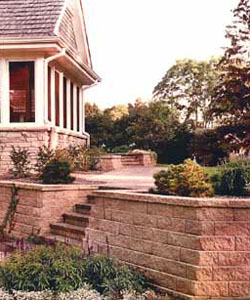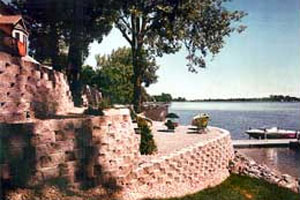September 15, 2003 5:00 AM CDT

The market continues to grow for all types of masonry retaining walls, from residential garden walls to tall sound barrier and heavy highway divider barricade walls. For years, normal weathering, acid rain, and road salts and acids have taken their toll on masonry walls. The surface corrosion and related discoloration has become a troubling problem for all types of walls, including concrete masonry blocks, pre-cast and segmental retaining walls. Greater exposure to salts and salt splash from roads and highways may also cause pre-mature spalling and shaling failures in walls.
Various reinforcing additives have been employed, but they were not economically practical and have proved not to be the answer. Several solvent-based sealers were tried but, being solvent based, they caused too many safety hazard issues of toxicity and/or flammability and too great a health threat to both the applicator and customer. So the industry had to seek a better, safer and more ecologically acceptable solution to the growing corrosion problem.
In this same period of time, many states started to employ new Volatile Organic Contents (VOC) and OSHA regulations prohibiting the use of most toxic and flammable solvent-type products due to stricter safety regulations developed by the Environmental Protection Agency.
Now the challenge grew to not only solve the growing corrosion problems but to do it without solvents. The biggest challenge was to develop products that would be able to insure a good bond and seal for corrosion protection while also providing an ecologically safe product.
Surebond, an industry leader in ecology masonry pavement sealers, worked on answers to this compounded problem. The company had developed the first ecology pave and pavement sealers, one-step interlocking paver seal, and joint sand bonding sealers, so it employed the same three ingredients to solve this problem. This combination of chemistry, engineering and masonry science was applied to produce not one, but two new products: Surebond Protect-A-Wall and Surebond Joint Stabilizing Sealer. Both offer protection against weathering and acid rain, and are salt and salt spray resistant. They are non-hazardous and comply with OSHA, EPA and VOC regulations.

The expanded use of more decorative and colorful residential retaining walls and the large growth of the dry-stack retaining walls for residential and commercial hardscapes has greatly increased the need for protective sealers. The new clear protective sealers enrich the appearance of both the natural and color pigmented retaining walls while also providing corrosion resistance.
For retaining walls in the more corrosive areas near or along streets, where road splash-up and misting can occur, protective sealers give an added protection to keep the walls bright and clean. For coastal regions where constant salt spray eats away, discolors and darkens, and eventually destroys masonry walls, the employment of these clear protective sealers is even more important.
The proper application of a sealer to insure complete surface coverage is critical. A heavy spray application is recommended to seal, with back-rolling to insure the sealer is forced into all cracks and crevices. For concrete block and mortared walls, back-rolling in both the vertical and horizontal directions will insure that all joints and low spots are property sealed.
Another advantage in using the sealers is their added benefit of mold protection. With the recent press and studies on illnesses being caused by toxic molds in mind, the Protect-a-Wall sealer resists various molds and passes the ASTM-D 3273-94 mold resistance tests. In many areas, the demand for mold resistant and health protective sealers is more critical, whether it is for a residential entertainment patio where food is served or for large outside public areas.
The additional benefits of these ecology sealers — ensuring cleanliness and ease of food removal — are tremendous for both masonry walls and pavements. Sealing masonry with the mold resistant sealers also reduces potential weed growth and undesired insects, such as ants.
While the use of ecology sealers provides many benefits and does improve functional performance of masonry retaining walls and pavements, they are not designed to compensate for sub-grade masonry products or improper installations. The use of protective sealers is to add life, better function and appearance, cleanliness and reduce maintenance, but should never be used to cover mistakes or faulty substandard product or workmanship.
Solving Masonry Retaining Wall Corrosion Problems
By Garry Perkins, Peter van Niekerk

Clear protective sealer resists mold and weathering to keep masonry walls clean.
Various reinforcing additives have been employed, but they were not economically practical and have proved not to be the answer. Several solvent-based sealers were tried but, being solvent based, they caused too many safety hazard issues of toxicity and/or flammability and too great a health threat to both the applicator and customer. So the industry had to seek a better, safer and more ecologically acceptable solution to the growing corrosion problem.
In this same period of time, many states started to employ new Volatile Organic Contents (VOC) and OSHA regulations prohibiting the use of most toxic and flammable solvent-type products due to stricter safety regulations developed by the Environmental Protection Agency.
Now the challenge grew to not only solve the growing corrosion problems but to do it without solvents. The biggest challenge was to develop products that would be able to insure a good bond and seal for corrosion protection while also providing an ecologically safe product.
Surebond, an industry leader in ecology masonry pavement sealers, worked on answers to this compounded problem. The company had developed the first ecology pave and pavement sealers, one-step interlocking paver seal, and joint sand bonding sealers, so it employed the same three ingredients to solve this problem. This combination of chemistry, engineering and masonry science was applied to produce not one, but two new products: Surebond Protect-A-Wall and Surebond Joint Stabilizing Sealer. Both offer protection against weathering and acid rain, and are salt and salt spray resistant. They are non-hazardous and comply with OSHA, EPA and VOC regulations.
Putting It On

Clear protective sealer resists mold and weathering to keep masonry walls clean.
For retaining walls in the more corrosive areas near or along streets, where road splash-up and misting can occur, protective sealers give an added protection to keep the walls bright and clean. For coastal regions where constant salt spray eats away, discolors and darkens, and eventually destroys masonry walls, the employment of these clear protective sealers is even more important.
The proper application of a sealer to insure complete surface coverage is critical. A heavy spray application is recommended to seal, with back-rolling to insure the sealer is forced into all cracks and crevices. For concrete block and mortared walls, back-rolling in both the vertical and horizontal directions will insure that all joints and low spots are property sealed.
Another advantage in using the sealers is their added benefit of mold protection. With the recent press and studies on illnesses being caused by toxic molds in mind, the Protect-a-Wall sealer resists various molds and passes the ASTM-D 3273-94 mold resistance tests. In many areas, the demand for mold resistant and health protective sealers is more critical, whether it is for a residential entertainment patio where food is served or for large outside public areas.
The additional benefits of these ecology sealers — ensuring cleanliness and ease of food removal — are tremendous for both masonry walls and pavements. Sealing masonry with the mold resistant sealers also reduces potential weed growth and undesired insects, such as ants.
While the use of ecology sealers provides many benefits and does improve functional performance of masonry retaining walls and pavements, they are not designed to compensate for sub-grade masonry products or improper installations. The use of protective sealers is to add life, better function and appearance, cleanliness and reduce maintenance, but should never be used to cover mistakes or faulty substandard product or workmanship.
About the Authors
Garry Perkins, President of Surebond Incorporated, is the inventor and manufacturer of the SB-1300-1370 sealers. Perkins has several years experience developing sealants and holds dozens of patents.
Peter van Niekerk, President of Surebond International, is the pavement sales engineer and master distributor of Surebond pavement products.


















